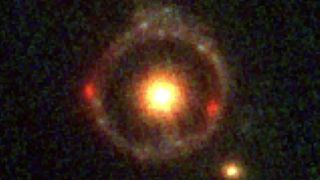A recent discovery by the James Webb Space Telescope (JWST) has sent ripples of excitement through the scientific community. The detection of a colossal ancient galaxy, dubbed JWST-ER1g, has not only provided a glimpse into the early universe but also offered valuable insights into the elusive concept of dark matter.
A Cosmic Lens and a Ring of Light
JWST-ER1g, formed a mere quarter of the way into the universe’s current age, holds a unique distinction. This massive galaxy acts as a powerful gravitational lens, bending the light from a distant source and warping it into a near-perfect Einstein ring – a phenomenon predicted by Einstein’s theory of general relativity. The resulting ring allows astronomers to peer through a natural cosmic magnifying glass, offering an unprecedented view of the distant universe and the objects within it.

Dissecting the Mass: Unveiling Dark Matter
The total mass encompassed within the Einstein ring comprises two key components: the mass of stars and the invisible dark matter. By meticulously subtracting the estimated stellar mass from the total mass, scientists can arrive at an estimate for the dark matter content within the ring. However, the initial calculations revealed a surprisingly high dark matter mass, exceeding expectations and sparking a scientific puzzle.
Professor Hai-Bo Yu of UC Riverside, along with his team, delved deeper into this conundrum. Their findings, published in The Astrophysical Journal Letters, propose a possible explanation for the unexpectedly high dark matter density.
The Enigma of the Dark Matter Halo
Galaxies like JWST-ER1g are enveloped in a vast halo of dark matter, an invisible form of matter theorized to constitute a staggering 85% of the universe’s matter. While it remains undetected in laboratories, its gravitational influence is undeniable. Dark matter’s presence can be inferred from its gravitational effects on visible matter, such as stars and gas. It is the invisible scaffolding that holds galaxies together and shapes their large-scale structure.
A New Theory on Dark Matter Distribution
Demao Kong, a graduate student at UCR leading the analysis, suggests a possible explanation for the high dark matter density observed around JWST-ER1g. When ordinary matter, such as gas and stars, condenses within the dark matter halo of JWST-ER1g, it might be compressing the halo itself, leading to anomalously high density. This novel theory, if proven correct, could significantly alter our understanding of dark matter’s behavior and distribution within galaxies.
A Unique Opportunity and JWST’s Contribution
The exceptional nature of JWST-ER1g, formed a mere 3.4 billion years after the Big Bang, presents a golden opportunity to study dark matter. “This strong lensing object is unique because it has a perfect Einstein ring,” explains Daneng Yang, a postdoctoral researcher at UCR. “This ring provides invaluable information about the total mass within it, a critical step for testing dark matter properties.” By studying the properties of the Einstein ring and the light that travels through it, scientists can glean crucial insights into the nature and distribution of dark matter within JWST-ER1g’s halo.
Launched in 2021, the James Webb Space Telescope serves as a powerful infrared observatory, peering into the depths of the cosmos with unprecedented clarity. “JWST offers an unprecedented opportunity to study these ancient galaxies,” remarked Professor Yu. “We can expect more surprises and a deeper understanding of dark matter to emerge from JWST’s observations in the near future.” JWST’s advanced capabilities promise to unveil a wealth of new information about not only dark matter but also galaxy formation, the early universe, and the potential existence of habitable exoplanets. This discovery and the ongoing research efforts hold immense promise for unraveling the mysteries surrounding dark matter, a fundamental component of our universe yet to be directly observed. The upcoming data from JWST and other telescopes designed to study dark matter hold the potential to revolutionize our understanding of the cosmos and rewrite our cosmic story.



















